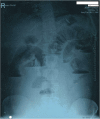Transmigration of a retained surgical sponge: a case report
- PMID: 30127854
- PMCID: PMC6087538
- DOI: 10.1186/s13037-018-0168-y
Transmigration of a retained surgical sponge: a case report
Abstract
Background: A retained surgical sponge remains a dreaded complication of modern surgery. Despite the increasing focus on patient safety instances of "a sponge being left in the abdomen", are all too common in popular media. In this article we report the rare phenomenon of transmigration of a retained surgical sponge in a patient who underwent laparoscopic sterilization.
Case presentation: A 30-year-old female presented with progressive abdominal pain for about one month and vomiting with obstipation for 2 days. The patient had undergone laparoscopic sterilization 7 years back and then underwent re-canalization one year back. She underwent an exploratory laparotomy for suspected adhesive small bowel obstruction. During surgery, an intra-luminal surgical sponge was recovered from the distal small bowel. The patient recovered and was discharged in good health.
Conclusion: Despite numerous advances in terms of technology and the ever-growing emphasis on patient safety, the problem of a retained surgical sponge remains a dreaded potential complication. All clinicians and health care professionals should be aware of this entity and its various presentations.
Keywords: Case report; Gossypiboma; Retained surgical items; Retained surgical sponge; Textiloma.
Conflict of interest statement
Not applicable. Written informed consent for publication obtained from the patient. The authors declare that they have no competing interests. Springer Nature remains neutral with regard to jurisdictional claims in published maps and institutional affiliations.
Figures
References
Publication types
LinkOut - more resources
Full Text Sources
Other Literature Sources




